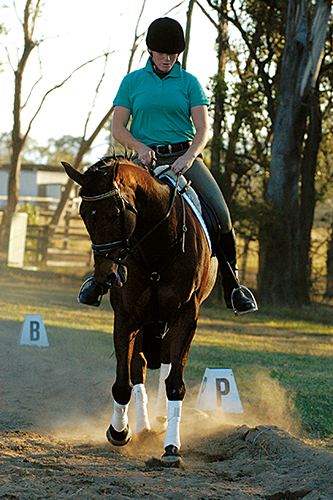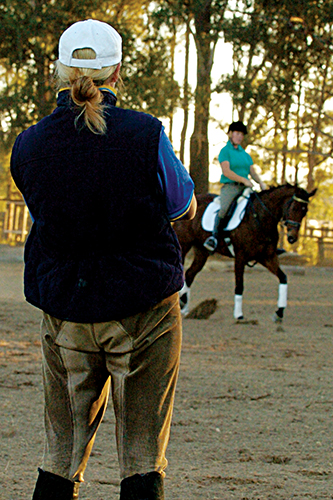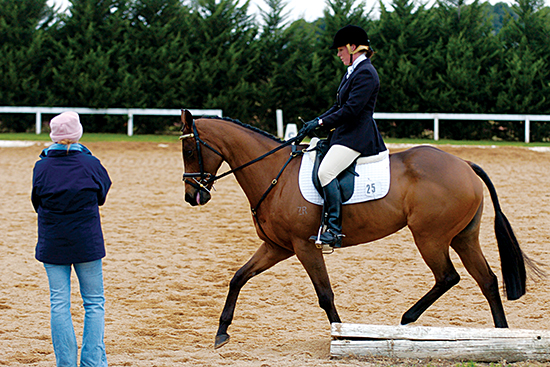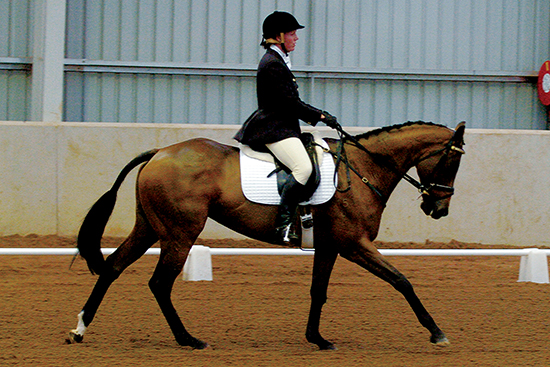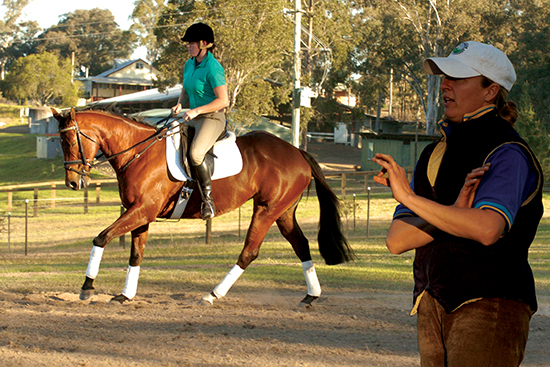 Story by Chris Hector & Photos by Roz Neave
Story by Chris Hector & Photos by Roz Neave
In Australia we are so lucky to have so many really good eventing instructors. I guess it is probably because Aussie eventers, even the ones competing at the highest level, have to instruct to keep feeding their horses (and their trucks).
Christine Bates is one of those instructors who has tasted success at the highest level, and still has the desire to wear the flag on her jacket lapel, but in the meantime, chooses to share her wealth of experience and knowledge.
In fact in this instance, she not only instructs the rider, but also provided the horse! In truth it was the promise of the ride on the eight year old Davine Story that lured nineteen year old Tallara Barwick to come and work with Christine and her husband, Matthew, in their recently established training centre at Willow Park (formerly Miguel Tavora’s centre) in Windsor.
Once named leading lady event rider in the world by l’Année Hippique in 1999 after she won both Melbourne and Sydney 3DEs (admittedly l’Année did manage to confuse Christine McLeod – as she was then – and Sammi McLeod, and added Sam’s results to Christine’s, or vice versa). In 2001, Christine was the leading NSW Eventing Rider with Masterprint and Another Story. In 2002, Christine cleaned up at Kooralbyn 3DE winning the one star on Newsprint, the two star on Reprint and placing second in the three star on Masterprint.
Tally was stepping into some formidable shoes, and while she only took over the ride on the sweet little Thoroughbred mare a couple of months ago, she had already tasted success with a third in the One Star at Sydney 3DE, and a win at Coffs Harbour.
When we visited Christine, Tally and ‘Cruising’ at Wilberforce, it was just on a week out of Melbourne, and Christine was intent on polishing the pair’s dressage test…
“Between now and Melbourne 3DE, you are not going to improve on what you’ve got, so you need to fine tune. Know where your weaknesses are, know your strengths, and between now and your test, work on breaking down each movement, and make sure you know exactly how to ride each step.”
What are this horse’s strengths?
“This mare is naturally a good mover. She is very very rideable, she doesn’t change when she goes from the working at home to the competition setting. You can rely on her, which means you can then focus on polishing the test. Her main strength would be that you can ride a very accurate test.”
Weaknesses?
“Probably the way she is built, she is a little downhill, so she does struggle to stay engaged and up in the poll. She likes to get low in her wither and trundle along on her front end sometimes. So we are going to focus on keeping her very active behind and allow her to come out of the wither, which will keep her up in front.”
Did she race?
“She was given a preparation but never even made it to a trial. She actually did a stint as a polo pony.”
The fact that all the good instructors operate along much the same lines might not make for wildly exciting reportage, but it certainly makes for good riding. So we start with Tally getting Cruising’s head and neck down, that all important loosening up work that forms the basis of any intelligent training program.
“Leave her down long and low, let her stretch, let her warm up – making sure she stays in front of your leg.”
“She’s a mare that can be cold backed, usually if I haven’t ridden her for a while, I’ll pop her on a lunge. Being a mare, if she’s a bit cold backed and you get on and say ‘right you are going to go forward now, and do this now’, she can get a bit anti. Why go looking for an argument when all it takes is five minutes of long and low, or on the lunge?”
Does she get serious?
“I have fallen off her. If she does put her head down, she is very very quick but it is not an every day thing. It is when she’s had a length of time off, and I’ve said, ‘she’ll be right’, got on her – and I’ve ended up on the ground. She doesn’t generally want to do the wrong thing, she doesn’t particularly want to buck – but yes, if she does, they are good ones.”
Even though we are working at home, the mare is being worked in a false tail…
If you are showing a horse in a false tail, do you work the horse in one at home to get it used to the tail?
“It’s like riding in your tails jacket at home. I found out the hard way with Reprint a couple of times. At Kooralbyn one year, I’d competed in tails a couple of times, but when I got on 20 minutes before my test, he said: ‘No, I actually don’t like tails’ and promptly pig rooted for 15 minutes until Wayne Roycroft said, ‘take them off, take them off’. Anything like that – false tails, long tails on your jacket, anything the horse can use as an excuse for a resistance, then you should train with them in place.”
“At the moment, our property is getting a make over, the arena is only half done with the logs, and I tell the owners, come on in, bring the trucks, bring the tractors, I don’t care if there are kids and dogs running around. The more de-tuned they are to what is going on around them, the better they are going to perform in the ring. Pressure the horse at home, make the surroundings as exciting as possible, so that when you go out, you can back off them, and trust your schooling and know they are going to stay with you in the test.”
Christine may be directing the dialogue to my digital recorder, but her eyes are well and truly focussed on what is going on in the arena:
“Get her more around your leg, and forward. Don’t let her drop behind your leg. Outside rein, don’t let her get stuck on the inside rein, try and let go of the inside rein. Straighten the neck – go full arena.”
She’s got a nice straight canter…
“For her size, she actually has quite big paces, and through playing around through a few things, I realised that she is actually lazy, you have to warm her up very forward, have her thinking very forward, and then when you want to collect her up and use your half halts more, then you can get her to sit behind. If you haven’t got her in front of your leg, she’ll get resistant, and heavy in your hand.”
“She tries hard, she is not necessarily built to be a great dressage horse but she does have good paces. The mare side of her is that you have to be more compromising than you can be with a gelding, if you can get her to work with you, and not against you, you can get very good work out of her.”
The look you are trying to get in the test is emphasising the rideability rather than saying ‘hey look we’ve got the super mover?’
“One thing that I particularly insist on with my horses, is that they have to be submissive and rideable. I don’t want to throw away marks because my horses are not submissive. I like the horses to be in front of my leg, in a nice contact, and engaged. I can’t cope with them just being in a frame and not coming through from behind. I’ve probably done a few tests on this mare that from a judge’s point of view have been a bit quick, but I would rather in a training situation at a One Day Event, go – right, you are going to learn to stay in front of my leg in a test. I will happily blow a movement at an ODE to educate the horse. Everything in the training is built around producing the ultimate test at the Three Day Event.”
“Going back to Reprint, he was a very difficult horse with a lot of ability. Nine times out of ten if you went to the scoreboard at an ODE he might be winning – but on the other hand he could be very very last because he’d decided to go levading across the arena instead of doing counter canter. I will have an argument and sacrifice that event for the ultimate goal of training my horse.”
“Okay Tally, when you are ready let’s go working trot sitting and stay up. Go large arena. I want to see a couple of half halts down the long side then ride her forward again. She’s got to stay up. Circle, let’s have her a little more around your inside leg. Slow down a little, half halt again and go forward, KEEP HER UP.”
Your students ride corners…
Christine laughs. “Tally got a major drilling the day before yesterday on riding corners. That is my pet hate, there is nothing worse than getting on a horse in an arena, and it doesn’t go into the corners.”
Especially as you are throwing away the best way of setting them up – corners are rider bonuses…
“Exactly. Now for the shoulder in, use your corner, don’t allow the forehand to get quite to the long side, inside hind, stay forward, don’t lose your rhythm, watch your inside leg – don’t drag your inside heel up.”
“For the right rein shoulder in don’t get too much right bend, you always have her a little bit kinked to the right. You didn’t set her up as well as you did for the left shoulder in, you didn’t quite get the inside hind through your corner.”
“I want to make sure that when you come out of the corner, that you have that shoulder in, you were almost to R before you had shoulder in.”
“Now turn a little circle, give and take with the inside rein, don’t support her with the inside rein, you’ve got to think more of inside leg to outside hand.”
“Now let’s go medium across the diagonal, think about keeping the even rhythm – no, you had her flexed to the outside. Back to working, you must have her round your inside leg around the turn and then she must be straight when you go across the diagonal. Remember to keep half halting her in the medium when she starts to roll over, you’ve got to help her by giving her a half halt then pushing her through from behind.”
“I want you to come out of the next corner in travers, so set it up, set it up, get her round your inside leg now, stay there, that’s plenty, keep the rhythm, she must stay forward, good, keep going.”
You like travers?
“I think travers is a very good schooling aid, if they know travers then it makes teaching the half pass so much easier. I do a lot of lateral work from very early on.”
“I find young riders have problems with horses not being around their leg enough. You only have to watch them riding tests and you see that they don’t use their turns, their horses aren’t around their leg, and it is such a basic training thing. The horses have got to be on the aids.”
“Now right travers again, keep your leg on, both legs, try and keep the weight more down in your inside leg, and push yourself to the outside. Watch that she doesn’t get too low in front. We have a head tilt, try and give and take with that inside rein. The mare has a tendency to get heavy in the right rein, we are working on trying to get her off the right rein, getting her to work on the outside rein a little more.”
“What I am trying to get Tally to do, is stay in travers, and straighten her neck, I don’t mind if she is almost in leg yield to try and keep that outside rein more – that’s why I keep saying, give and take that inside rein, allow her to straighten so you can pick up the outside rein. Change rein through the centre of the circle, up a little, she is getting low…”
“Now half pass, and be careful, if she gets too low in front, then her front legs start to dive into the ground. Keep the inside leg there, careful don’t lead with the quarters, inside leg, don’t let her shoot across because you’ve put the outside leg on.”
Time for canter:
“Stay up, stay up, you must stay active in your canter, and around your inside leg, make sure you have the inside hind, now medium along the long side. I want to see two clear transitions. Don’t let her pop her quarters in. Good, across the diagonal to a 20 metre counter canter circle. Keep the jump in the canter, don’t let the canter get inactive. Stay up, you needed a half halt in the second half of your circle.”
Time to ride the actual test.
“You over-shot the centre line, come round and do that again. That’s much better – nice and straight. Watch you are not getting too quick. You are almost pushing her out of her rhythm there. The circle was a touch too big, you went over the centre line. She came above your hand in that upward transition, you look like you need to give her more warning about what is coming up. It was going to be quite good and then you pushed her out of her rhythm til she was almost in a run, you could have used a few more half halts.”
“DERRR, you let her step back in the halt. The halt wasn’t long enough before you started the rein back. The rein back was going to be good but you only got three steps, then almost allowed her to stop and then continued on. That walk is good…”
Is that the scarey bit for eventers – the walk?
“It depends on the horse – once a horse is established in its work, then I train the walk quite a lot. With the young horses, the walk is not something that I play around with at all. Once the horse is doing trot and canter, is on my aids and has a good understanding of that – then I play around with the walk. I think a lot of people try to play around with the walk on young horses, and that is one pace that can be totally destroyed if you don’t go about it the right way.”
“This mare, I don’t think she would even know how to break in the walk, she has always been very reliable, good to train, she is one of those horses, you drop the reins, she relaxes. But she has also been trained to go that way. Some horses – like Masterprint – always have that tendency to jog, it is a tension thing, I think they anticipate the canter is coming next.”
“In training we never go from walk to canter, always walk, halt, walk on, or walk, trot – so they never associate walk with canter. The walk, even though it is only one or two movements in the test, does count a big part in the overall collective marks.”
But it wasn’t good enough for this demanding coach:
“Okay, let’s start again from the end of your walk…”
And so it goes, polish, polish, making sure the details are in place, trying not to throw away a single mark.
THE DRESSAGE TEST AT MELBOURNE
Hard task master though she is, Christine was happy with the warm up for Tally’s dressage test when the big day came at Melbourne Three Day Event: “Tally is doing a great job, since the lesson a week ago, the frame has really improved. Everything has improved nicely. I think she should do a really good test.”
And despite a few little glitches, Christine was happy enough at the end of the test: “I think overall it was a very sweet, pleasant test. There were just a few little mistakes. The transition from E-X-B, she anticipated and actually halted instead of walked, little things like the halt was fantastic but the rein back was a little crooked. Just little things – she didn’t quite nail the transition from trot to canter both times. The frame was very consistent, rhythm was very consistent, probably Tally got a little caught out not quite keeping her in front of her leg but it was a sweet test.”
With a 55.2% Tally Barwick and Davine Story are sitting in equal 11th after the dressage – the great game has begun.
CHRISTINE’S STORY
When you are teaching a young rider like this, is it an issue to be on one level demanding and strict enough, and yet you want them to come out of the arena positive, not thinking they are hopeless…
“Very much so. I’ve taught Tally on and off over a couple of years, but this is the first time one on one. Tally naturally tries very hard so I’ve got to be careful not to overload her brain with information. You’ll say – ‘I really want her up’ and Tally will go, must be up must be up, and forget to ride everything else.”
“Most kids if you start overloading them with information and get too tough on one thing, then they’ll forget about everything else you’ve been telling them to do. We all make mistakes and we all have to learn from them, it doesn’t matter how many times you are told ‘don’t do that’, you can’t teach that – they’ve got to find it out for themselves. Horse riding is one of those things you can’t teach, it’s a matter of trying, trial and error for each individual person until they understand and they can get it. You can’t just keep force feeding them information and expect them to get it all, they all take their own time to get where you want them.”
Is it easier for you to teach her because you’ve competed on the horse she is riding?
“Yes and no. With all my lessons, whoever I am teaching, I always get on and have a feel because sometimes what you are seeing is not always what they are feeling, they might be doing something I am not necessarily going to pick that up, until I’ve actually sat on the horse.”
“Sometimes I might do things as a rider that I wouldn’t necessarily teach. Tricks of the trade to learning to ride a test… I try to teach as classically as I can, but when you are actually riding a test, it doesn’t mean you are riding classically.”
Originally published in THM October 2005.


